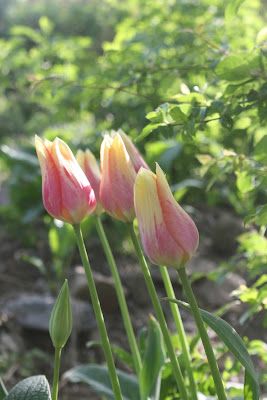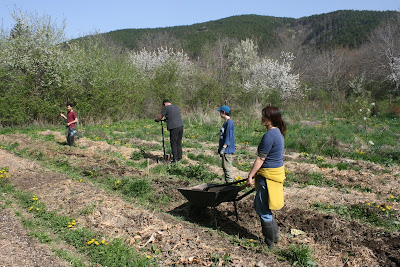With the new perennial garden plantings in, raised beds prepped and seeds sown for the market garden, this week was mainly maintenance (watering, weeding) and time to start work on an unfinished project.
 |
| Plants, Seeds, eBooks, Consultancy, Bulk Fruit and Nut Tree Orders for Permaculture, Polyculture, Forest Gardens and Regenerative Landscapes. |
Water Harvesting Reservoir
We're looking to supply the irrigation needs for the garden at the volunteer house with just rain water by storing the water collected from the roof in a reservoir. This will be the first pond/reservoir that we've made with a rectangular shape (approx 2.5 m deep 2 m wide and 6 m long). The rectangular shape and depth of this reservoir will reduce evaporation but it's unsuitable for attracting the diversity of aquatic plant life and insects that we usually have in our ponds. We do plan to introduce some habitat in the way of floating islands and land/water interfaces for frogs and other aquatic wildlife Rectangular shape reservoirs often become breeding grounds for mosquitos and the habitat should provide control for the mosquitos and offer some pest control and support in the gardens.
Last summer we excavated the hole for the reservoir. The pond is located on the highest point in the garden. The guttering as seen on the left side of the photo, will be extended over the grape arbor and into the pond.
Angela and Malcolm using the transit level to establish a level bank around the reservoir.
Stakes in and string tied around each stake to mark the level of the pond
Quite a bit of soil had washed into the hole over the winter so we cleaned the hole up removed sharp stones ready for applying the liner. Here's Malcolm undertaking the vital role of selecting a playlist before the digging commences :)
We still need to level the banks of the pond but we thought we'd get the liner in before the spring rains come down. We're using a trilaminate LDPE liner for this pond
Last year I wrote a series of blogs on small pond installations for farms and gardens, so if you are interested you can find much more detail about the process there.
Planting in the Perennial Polyculture Trial Garden - Ataraxia
Seeing as it has not rained for the last 3 weeks or so we checked this season's plantings and watered where necessary. We also planted the last of the plants for this spring into an overflow swale that we prepared last year on our Regenerative Landscape Design Course.
 |
| The lovely folk from last years Regenerative Landscape Design Course creating the overflow swale. |
The swale takes the overflow from the pond. The basin (low section) was sown with nitrogen fixing ground cover and the berm (high section) was planted with various trees, shrubs, herbs and bulbs.
The above photo does not capture the diversity of planting but this 2.5 m x 10 m swale is currently inhabited by the following plants
Trees
Shrubs
Herbs
Bulbs
Green Manure of Onobrychis viciifolia - Sainfoin and Trifolium repens - White Clover has established well since the sowing last June.
 |
Wildlife in the Gardens
Been seeing these bagworms around recently which despite the name are actually moths. These guys are quite the architects building mobile homes with pieces of twigs, leaves and other plant matter. The larvae begin to build the case as soon as they hatch. The females will remain in the case their entire lives while the males will eventually take flight for a day or two, find a mate and then perish.
 |
| Psychidae - Bagworm or Bagmoth - genus, species unknown |
 |
Carpenter bee - Xylocopa sp. - Photo by Lyubomir Durankiev |
European green lizard (Lacerta viridis) taking cover in a hawthorn shrub in Ataraxia. We've had to remove some of the shrubs in the garden to make way for the raised beds but we pile the branches at the side of the garden to provide the cover these amazing reptiles require.
 |
| Lacerta sp. taking cover in shrub |
 |
| Lacerta sp. taking cover in the piles of sticks from the shrubs we removed |
Here's a short video from Dylan of some wildlife in the gardens last week
Forest Garden
Despite the fact we have had next to no rainfall since April, the forest garden is looking lush and all the plants are doing great. The forest garden is composed of several layers and when planted appropriately, a forest garden allows for a greater density of resources and can be a largely self- fertilising, and healthy ecosystem. In the picture below I have labelled the tree and shrub layer ,although there are probably over 300 species in this photo if you include the smaller shrubs, herbs and ground layers. Profiles of some of the plants we grow in each layer in our forest gardens can be found here.
 |
| Forest Garden / Food Forest |
Comfrey among the Raspberry and Blackcurrants. As Symphytum x uplandicum - Comfrey Bocking 14 starts to flower is the ideal time for cutting to ground level and applying as mulch but it's always good to let a few plants flower for the bees and beauty.
 |
| Symphytum x uplandicum - Comfrey Bocking 14 |
Regenerative Landscape Design - Online Interactive Course
Want to learn how to design, build and manage regenerative landscapes? Join us for our Regenerative Landscape Design - Online Interactive Course from May 1st to Sep 13th, 2023.
We're super excited about running the course and look forward to providing you with the confidence, inspiration, and opportunity to design, build and manage regenerative landscapes, gardens, and farms that produce food and other resources for humans while enhancing biodiversity.

Regenerative Landscape Design Online Course
You can find out all about the course here and right now we have a 20% discount on the full enrollment fees. Just use the promo code RLD2023 in the section of the registration form to receive your discount.
We are looking forward to providing you with this unique online learning experience - as far as we know, the very first of its kind. If you are thinking of reasons why you should do this course and whether this course is suitable for you, take a look here where we lay it all out. Looking forward to it!
We're super excited about running the course and look forward to providing you with the confidence, inspiration, and opportunity to design, build and manage regenerative landscapes, gardens, and farms that produce food and other resources for humans while enhancing biodiversity.
 |
| Regenerative Landscape Design Online Course |
You can find out all about the course here and right now we have a 20% discount on the full enrollment fees. Just use the promo code RLD2023 in the section of the registration form to receive your discount.
We are looking forward to providing you with this unique online learning experience - as far as we know, the very first of its kind. If you are thinking of reasons why you should do this course and whether this course is suitable for you, take a look here where we lay it all out. Looking forward to it!
--------------------------------------------------------------------------------------------------------------------------
Support Our Project
If you appreciate the work we are doing you can show your support in several ways.
- Make a purchase of plants or seeds from our Bionursery or Online Store
- Consider joining us for one of our Courses or Online Courses
- Comment, like, and share our content on social media.
- Donate directly via PayPal to balkanecologyproject@gmail.com or via FTX Pay
If you appreciate the work we are doing you can show your support in several ways.
- Make a purchase of plants or seeds from our Bionursery or Online Store
- Consider joining us for one of our Courses or Online Courses
- Comment, like, and share our content on social media.
- Donate directly via PayPal to balkanecologyproject@gmail.com or via FTX Pay
 |
| You can also register for our online training, services, and products directly here. |
--------------------------------------------------------------------------------------------------------------------------
--------------------------------------------------------------------------------------------------------------------------
















































